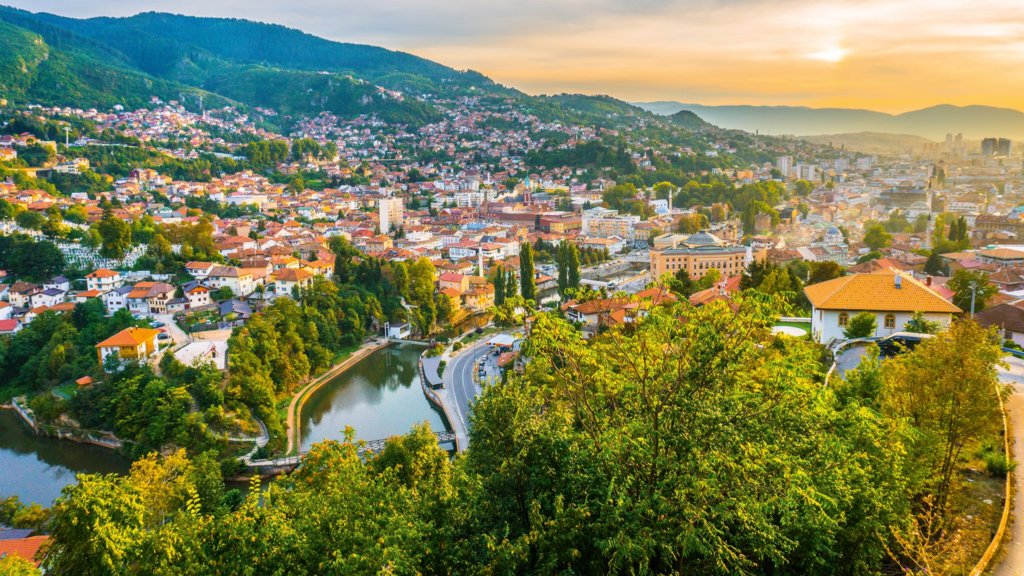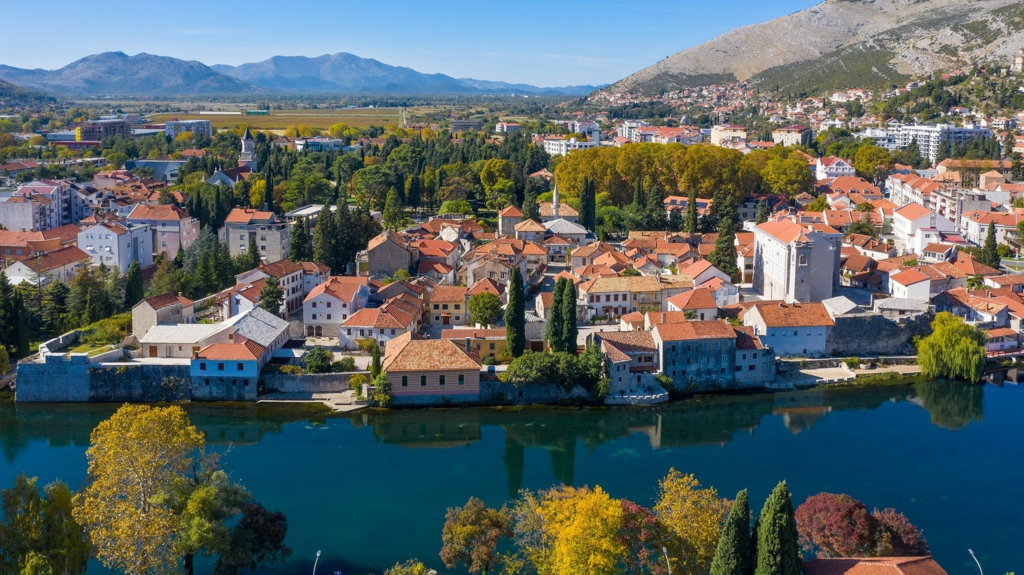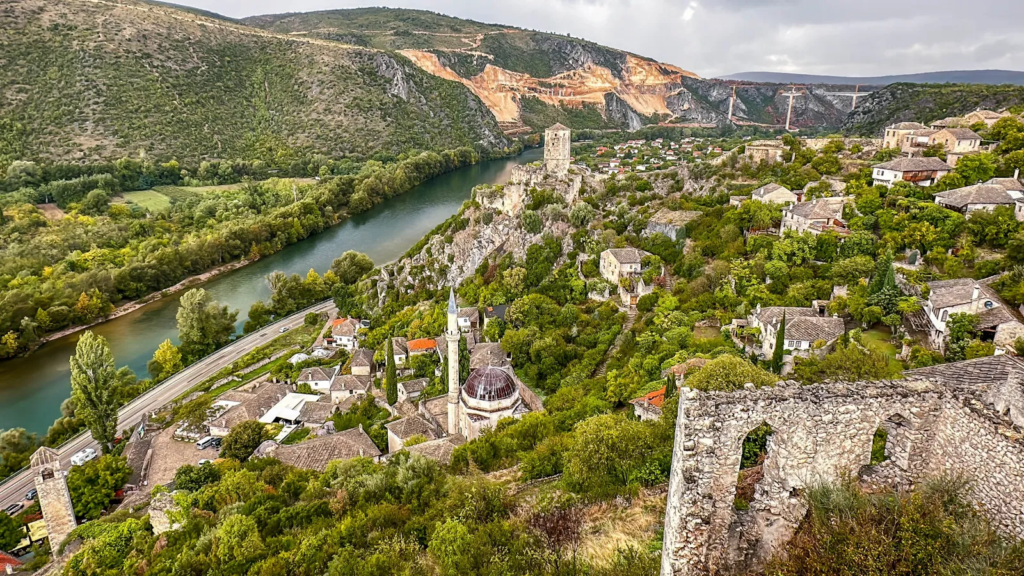Bosnia and Herzegovina, often simply referred to as Bosnia, is a country located in Southeastern Europe on the Balkan Peninsula. It is a stunning country with a rich history and diverse culture, making it an intriguing destination for travelers seeking both historical depth and natural beauty. Known for its picturesque landscapes, medieval architecture, and warm hospitality, Bosnia and Herzegovina offers a unique blend of Eastern and Western influences that reflect its complex past. From the bustling streets of Sarajevo to the serene beauty of the countryside, the country captivates with its charm and resilience.
Table of Contents
Geography
Bosnia and Herzegovina covers an area of approximately 51,197 square kilometers, with Sarajevo as its capital and largest city. The country’s landscape is predominantly mountainous, with the Dinaric Alps extending across its western edge. Its central and southern regions are characterized by hilly terrains and valleys, while the northeast features the flatlands of the Pannonian Basin. The country also has a small coastline along the Adriatic Sea, stretching about 20 kilometers around the town of Neum. Bosnia and Herzegovina is bordered by Croatia to the north, west, and south; Serbia to the east; and Montenegro to the southeast. This strategic location in the Balkans has historically made it a crossroads of various cultures and civilizations.
States of Bosnia and Herzegovina
Bosnia and Herzegovina is divided into two main political entities and one autonomous district:
- Federation of Bosnia and Herzegovina (FBiH): This entity is further divided into 10 cantons, each with its own government.
- Republika Srpska (RS): This entity operates as a centralized government without cantonal subdivisions.
- Brčko District: This is a self-governing administrative unit that is officially under the sovereignty of both the Federation of Bosnia and Herzegovina and Republika Srpska, but it operates independently from both entities.
So, while the country does not have “states” in the traditional sense, it has these three main divisions.
Historical Background
Bosnia and Herzegovina has a complex history shaped by various civilizations and empires. The region has been inhabited since the Neolithic period, with evidence of early settlements found in the Butmir culture near Sarajevo. During the Roman era, the area was part of the province of Illyricum. Following the fall of the Roman Empire, the region became a battleground for control among the Byzantine Empire, the Kingdom of Croatia, and the medieval Kingdom of Bosnia.
The medieval period saw the rise of the independent Kingdom of Bosnia, which reached its peak in the 14th century under the rule of King Tvrtko I. However, the kingdom eventually fell to the Ottoman Empire in the late 15th century. The Ottomans ruled Bosnia for over four centuries, leaving a lasting legacy in the form of Islamic architecture, cultural practices, and a significant Muslim population.
In the late 19th century, Bosnia and Herzegovina came under the administration of the Austro-Hungarian Empire following the Congress of Berlin in 1878. This period saw significant modernization and development, including the construction of railways, schools, and administrative buildings. The assassination of Archduke Franz Ferdinand of Austria in Sarajevo in 1914, which sparked World War I, highlighted the region’s geopolitical significance.
After World War I, Bosnia and Herzegovina became part of the Kingdom of Serbs, Croats, and Slovenes, later known as the Kingdom of Yugoslavia. During World War II, the region experienced brutal conflict and occupation by Axis forces, leading to the establishment of the Socialist Federal Republic of Yugoslavia under Josip Broz Tito after the war. Bosnia and Herzegovina remained one of the six republics within Yugoslavia until its dissolution in the early 1990s.
The breakup of Yugoslavia in the 1990s led to a brutal and devastating conflict in Bosnia and Herzegovina, known as the Bosnian War. The war, which lasted from 1992 to 1995, resulted in significant loss of life, displacement, and destruction. The Dayton Agreement, brokered in 1995, brought an end to the conflict and established the country as an independent state with a complex political structure designed to ensure representation for its three main ethnic groups: Bosniaks, Serbs, and Croats.
Top Ten Must-Visit Destinations in Bosnia and Herzegovina
Bosnia and Herzegovina, with its rich history, diverse culture, and breathtaking landscapes, is a treasure trove of must-visit destinations. Here are ten places that should be on every traveler’s itinerary when visiting this fascinating country:
1. Sarajevo

Sarajevo, the capital city, is a vibrant blend of East and West, with a rich history that spans centuries. The city’s historic center, Baščaršija, is a bustling bazaar filled with cobblestone streets, Ottoman-era buildings, and vibrant market stalls. Key landmarks include the Gazi Husrev-beg Mosque, the Latin Bridge (site of the assassination of Archduke Franz Ferdinand), and the Sarajevo Tunnel Museum, which provides insight into the city’s wartime history.
2. Mostar

Mostar is renowned for its iconic Stari Most (Old Bridge), a UNESCO World Heritage site that symbolizes the city’s resilience and unity. The bridge, originally built in the 16th century and reconstructed after the Bosnian War, spans the emerald Neretva River. Visitors can explore the charming old town, with its narrow streets, traditional shops, and the Koski Mehmed Pasha Mosque, which offers stunning views of the bridge and the city.
3. Blagaj

Blagaj is a picturesque village located at the source of the Buna River, just a short drive from Mostar. The highlight of Blagaj is the Blagaj Tekija, a 16th-century Dervish monastery nestled against a cliff face beside the crystal-clear waters of the river. The serene surroundings and the spiritual ambiance make it a perfect spot for relaxation and reflection.
4. Kravice Waterfalls

The Kravice Waterfalls, located near the town of Ljubuški, are a natural wonder and a popular destination for nature lovers. The waterfalls cascade from a height of about 25 meters into a turquoise pool, creating a stunning and tranquil setting. Visitors can swim in the refreshing waters, picnic along the banks, or explore the lush surroundings.
5. Jajce

Jajce is a historic town known for its well-preserved medieval architecture and natural beauty. The town’s most famous feature is the Pliva Waterfall, which dramatically plunges into the Vrbas River right in the center of town. Visitors can also explore the Jajce Fortress, the Catacombs, and the AVNOJ Museum, which commemorates the town’s role in the formation of Yugoslavia.
6. Travnik

Travnik, once the capital of the Ottoman province of Bosnia, is a town rich in history and culture. The Travnik Fortress offers panoramic views of the town and surrounding valleys. The town is also known for its colorful Ottoman-style houses, the Sulejmanija Mosque, and the birth house of Nobel Prize-winning author Ivo Andrić.
7. Sutjeska National Park

Sutjeska National Park, the oldest national park in Bosnia and Herzegovina, is a paradise for nature enthusiasts. The park is home to the primeval forest of Perućica, one of the last remaining ancient forests in Europe, and the majestic Maglić Mountain, the highest peak in the country. Hiking, wildlife spotting, and exploring the pristine natural landscapes are popular activities in the park.
8. Trebinje

Trebinje is a charming town located in the southern part of the country, near the border with Croatia. The town’s Mediterranean atmosphere, historic old town, and the beautiful Arslanagić Bridge make it a delightful place to visit. The Hercegovačka Gračanica, a Serbian Orthodox monastery on a hill overlooking the town, offers breathtaking views of the surrounding countryside.
9. Počitelj

Počitelj is a historic village located on the banks of the Neretva River. The village is known for its well-preserved medieval architecture, including the Počitelj Fortress, the Haji-Ali Mosque, and the Gavrakanpetanović House. Walking through the narrow streets and ancient stone buildings, visitors can feel the rich history and cultural heritage of the area.
10. Vrelo Bosne

Vrelo Bosne is a natural spring located near the city of Sarajevo, at the foothills of Mount Igman. The spring is the source of the Bosna River and is surrounded by a picturesque park with wooden bridges, walking paths, and picnic areas. The tranquil environment and the beautiful scenery make it a popular spot for locals and tourists alike.
Culture and Heritage
Bosnia and Herzegovina’s culture is a rich tapestry woven from its diverse historical influences. The country’s unique blend of Eastern and Western traditions is evident in its architecture, cuisine, music, and customs. Sarajevo, the capital city, is often referred to as the “Jerusalem of Europe” due to its religious diversity, with mosques, churches, and synagogues situated in close proximity.
The country’s Ottoman heritage is particularly visible in cities like Mostar and Sarajevo. The Old Bridge (Stari Most) in Mostar, a UNESCO World Heritage site, is a symbol of reconciliation and the resilience of the Bosnian people. The Gazi Husrev-beg Mosque in Sarajevo, built in the 16th century, is one of the most important Islamic structures in the Balkans.
Bosnian cuisine reflects the country’s multicultural heritage, with influences from Ottoman, Mediterranean, and Central European culinary traditions. Popular dishes include ćevapi (grilled minced meat sausages), burek (savory pastry filled with meat or cheese), and dolma (stuffed vegetables). The coffee culture is also an integral part of social life, with traditional Bosnian coffee similar to Turkish coffee being a staple in households and cafés.
Natural Beauty
Bosnia and Herzegovina is renowned for its stunning natural landscapes, offering a diverse range of outdoor activities for nature enthusiasts. The country’s mountainous terrain makes it a haven for hikers, climbers, and skiers. The Dinaric Alps provide breathtaking vistas and challenging trails, while the Tara River Canyon is one of the deepest canyons in Europe, perfect for rafting and kayaking.
The country is also home to several beautiful national parks. Sutjeska National Park, the oldest national park in Bosnia and Herzegovina, is known for its primeval forest, diverse wildlife, and the iconic peak of Maglić, the highest mountain in the country. Una National Park, with its stunning waterfalls and pristine rivers, is another popular destination for nature lovers.
Top Eight Most Famous Food of Bosnia and Herzegovina








Economy and Development
The economy of Bosnia and Herzegovina is characterized by its transitional nature, moving from a centrally planned system to a market-oriented economy. The country has made significant strides in economic development since the end of the war, though challenges remain. Key industries include manufacturing, agriculture, and tourism.
Tourism has become an increasingly important sector, with the country’s rich cultural heritage and natural beauty attracting visitors from around the world. Efforts to promote sustainable tourism and improve infrastructure have contributed to the growth of this sector. Sarajevo, with its vibrant cultural scene and historical sites, and Mostar, with its iconic bridge, are among the top destinations for tourists.
Politics and Governance
Bosnia and Herzegovina has a unique and complex political structure established by the Dayton Agreement. The country is divided into two entities: the Federation of Bosnia and Herzegovina, primarily inhabited by Bosniaks and Croats, and the Republika Srpska, predominantly inhabited by Serbs. Additionally, there is the Brčko District, a self-governing administrative unit.
The political system is characterized by power-sharing mechanisms designed to ensure representation for the three main ethnic groups. The presidency is a tripartite body, with one representative from each of the three groups serving a rotating term. This system, while aimed at maintaining peace and stability, often leads to political gridlock and challenges in governance.
Challenges and Future Prospects
Despite significant progress since the end of the war, Bosnia and Herzegovina faces several challenges. Political fragmentation, economic disparities, and issues related to governance and corruption continue to hinder development. Additionally, the country grapples with the legacy of the war, including addressing war crimes and fostering reconciliation among its diverse communities.
However, there are reasons for optimism. The younger generation is increasingly engaged in efforts to promote positive change and build a more inclusive society. The country’s potential for tourism, its strategic location, and its rich cultural heritage offer opportunities for sustainable development and economic growth.
Conclusion
Bosnia and Herzegovina is a country of remarkable resilience, where the scars of its turbulent past coexist with the promise of a brighter future. Its diverse landscapes, rich cultural heritage, and the warmth of its people make it a destination worth exploring. As the country continues to navigate the challenges of the present, it remains a testament to the enduring strength of its people and the beauty of its land. Whether you are drawn by its history, its natural beauty, or its vibrant culture, Bosnia and Herzegovina offers a journey of discovery and a chance to witness the enduring spirit of a nation.

